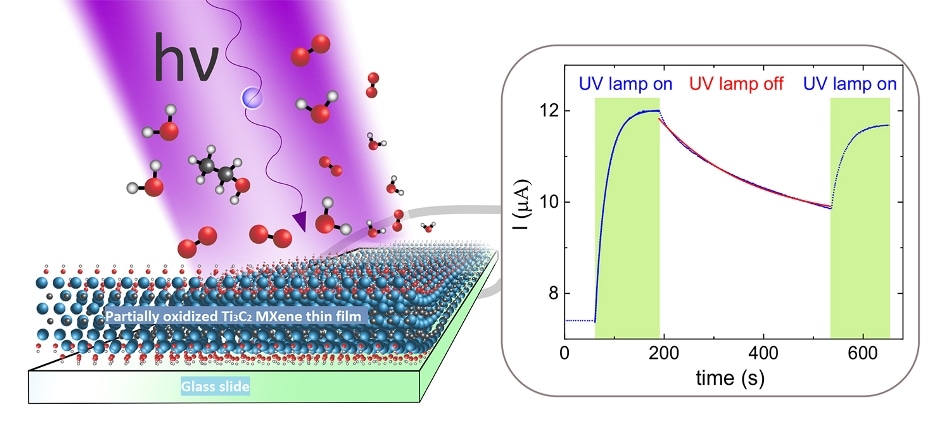Jun 21 2018
An innovative method for harnessing the capacity of a kind of spontaneously oxidizing MXene thin films, for developing nanocomposites with the ability to sense light as well as the environment, has been devised by scientists from Missouri S&T. Earlier, such spontaneous oxidation was regarded to be harmful since it degrades the structure of MXenes. The study has been reported in the June 2018 issue of ACS Nano, one of the top-rated, peer-reviewed scientific journals from Google Scholar.
 Illustration of environment-sensitive photoresponse of spontaneously partially oxidized Ti3C2 MXene thin film when exposed to UV light. Molecules in the surrounding environment modulate the photoresponse. (Image credit: Vadym Mochalin)
Illustration of environment-sensitive photoresponse of spontaneously partially oxidized Ti3C2 MXene thin film when exposed to UV light. Molecules in the surrounding environment modulate the photoresponse. (Image credit: Vadym Mochalin)
“Now we’ve demonstrated that partial spontaneous oxidation of MXenes into titanium oxide that is integrated with the MXene flakes, can be harnessed to inexpensively manufacture useful MXene-titania nanocomposites,” stated Dr Vadym Mochalin, principal investigator of the study, who is an associate professor of chemistry at Missouri University of Science and Technology.
“With the exponential increase in MXenes’ research over the past several years, conceptual discoveries are becoming less frequent,” stated Mochalin. “In parallel, researchers delve deeper into MXenes’ fundamental properties, in particular, the complicated chemistry of these materials.”
MXenes are two-dimensional inorganic compounds containing layers of nitrides and metal carbides that are few atoms thick. The nitrides and metal carbides exhibit high electrical conductivity and also hydrophilicity, nonlinear optical and tunable electronic properties. Since they are metallic conductors, they are not supposed to produce a photocurrent inside the material upon exposure to light, which is the case with typical semiconductors such as silicon.
However, in their June paper, “Environment-Sensitive Photoresponse of Spontaneously Partially Oxidized Ti3C2 MXene Thin Films” co-authored by Mochalin and Dr Sergii Chertopalov, a post-doctoral researcher in Mochalin’s team, the scientists measured a photocurrent through the samples by irradiating the partially oxidized thin Ti3C2 MXene films with ultraviolet (UV) light.
Materials scientists know titanium oxide as a photoresponsive semiconductor material for many applications - including photocatalysis, environment remediation and sensing - but its fabrication in the form of nanocrystals or nanofilms is expensive. Spontaneous oxidation is now demonstrated as a simple, inexpensive method to fabricate MXene-semiconductor transparent nanocomposite films for applications in UV photodetectors, photoresistors, sensors, and other devices whose electrical resistivity is responsive to UV radiation and changes depending on the molecules present in the environment.
Dr Sergii Chertopalov
When exposed to an ambient air, containing oxygen and atmospheric water vapor, the spontaneous oxidation of the titanium-based MXenes causes titanium oxide to form on the surface of MXene. The difference our research sets forth, is that we discovered that these partially oxidized thin films responded significantly to UV light, and their photoresponse strongly depends on the atmosphere they are exposed to. This finding opens the door for many new applications of MXenes.
Dr Vadym Mochalin
From 2011, when MXenes were discovered for the first time, Mochalin has extensively studied the materials, specifically their physical and chemical properties. Apart from MXenes and other 2D materials, Mochalin also performs research on nanodiamonds in interdisciplinary settings at Missouri S&T and largely collaborates with international researchers and companies that actively pursue research and development of MXenes.
Mochalin and Chertopalov intend to present the outcomes of the study at forthcoming nanotechnology, chemistry, and materials conferences. This study was partially funded by a start-up grant from Missouri University of Science and Technology.